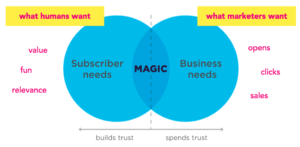
MozCon 2018: The Golden Rules for Human-Centric Email Marketing
The following post is part of WTWH Media Marketing Lab’s ongoing blog series from MozCon 2018.
Justine Jordan, VP of Marketing at Litmus, a SaaS company, has had over 10 years’ experience in e-mail marketing and is an expert in her craft. During her presentation at MozCon 2018, she explained how marketers and consumers view e-mails differently. Marketers tend to view e-mails as a cash machine and focus primarily on open rate and CTR. Consumers, however, see e-mail marketing campaigns as just another promotion in their inbox.

Image via Justine Jordan
So, where’s the disconnect? For marketers, the short-term gain of open rate and CTR is destroying long-term loyalty in the process. Jordan said we need to find the blend between consumer needs and business needs. Consumers report e-mails as spam when they don’t meet their expectations or if they find them irrelevant and unwanted. Marketers don’t get to decide what is spam, their customers do. As marketers, we need to build our campaigns to connect with customers, not an e-mail marketing list.
Rule #1: Always collect consent
When marketing to customers, make sure you are always getting consent and offering a clear opt-in or opt-out option. The General Data Protection Regulation (GDPR) says that consent requires a positive opt-in. To follow this rule, it’s important to keep consent separate from other terms and conditions and make it easy for people to withdraw consent. For businesses, keep records of all consents.
Rule #2: Create Accessible E-mails
Accessibility and design are both important factors in any marketing campaign. For e-mail marketing, check color contrasts and send a plain text version to help prevent your emails rendering as spam. Also, consider using semantic elements to reset weird Outlook styling.
Rule #3: Mobile Still Matters
When creating an e-mail marketing campaign, make sure your e-mail is optimized for mobile. Responsive design is still the status quo, and if you are not optimizing for mobile, you can lose up to 51% of subscribers.
Rule #4: Make it easy to unsubscribe
Too many marketers are making unsubscribing too hard. This can lead to consumers marketing your e-mail as spam because 50% of subscribers find it easier to mark as spam then unsubscribe.
Rule #5: Embrace inbox management controls
In other words, stop freaking out about the promotions tab. The promotions tab is not the spam folder.
Rule #6: Look beyond vanity metrics like opens and clicks
Don’t use tricky subject lines to increase your open rate or CTR. You will lose subscribers and trust.
Rule #7: Build a better list
By using e-mail list rentals, co-registration purchased e-mail lists and lead general forms, you are risking being blocked or blacklisted. Include an unchecked box and ask if your consumers would like to subscribe. Customers may want your research advice, but not your e-mails. Remember Rule #1 and always collect consent when building lists.
Jordan noted that an easy way to improve your e-mail marketing campaign is to follow the rules above and create e-mail briefs to use consistently as you are optimizing your e-mail marketing campaigns. An e-mail brief should include:
- Who should receive this message?
- What action should they take?
- Why will they take action?
- When should they receive the message?
- Where are they likely to read the message?
To recap, when creating an e-mail marketing campaign, consider the needs and wants of your customers. Keep your campaign respectful by collecting consent and letting your costumers easily opt in or out. Make it accessible and functional by keeping design and color contrast in mind. Prioritize optimizing for mobile so you are not losing subscribers. Use inbox management controls and don’t try to trick your customers with a misleading subject line to increase your open rate and CTR.



Leave a Comment
You must be logged in to post a comment.